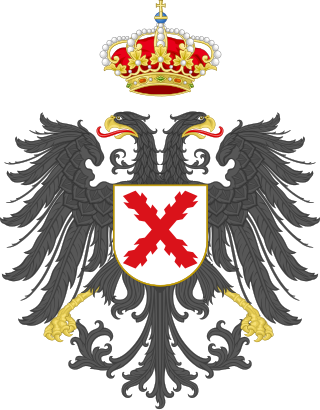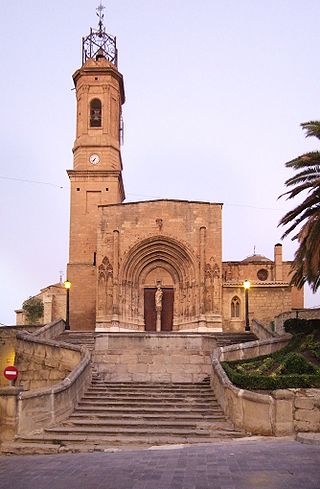Related Research Articles

Spanish omelette or Spanish tortilla is a traditional dish from Spain. It is celebrated as one of the most popular dishes of the Spanish cuisine. It is an omelette made with eggs and potatoes, usually including onion. It is often served at room temperature as a tapa.

Carlism is a Traditionalist and Legitimist political movement in Spain aimed at establishing an alternative branch of the Bourbon dynasty, one descended from Don Carlos, Count of Molina (1788–1855), on the Spanish throne.

The First Carlist War was a civil war in Spain from 1833 to 1840, the first of three Carlist Wars. It was fought between two factions over the succession to the throne and the nature of the Spanish monarchy: the conservative and devolutionist supporters of the late king's brother, Carlos de Borbón, became known as Carlists (carlistas), while the progressive and centralist supporters of the regent, Maria Christina, acting for Isabella II of Spain, were called Liberals (liberales), cristinos or isabelinos. Aside from being a war of succession about the question who the rightful successor to King Ferdinand VII of Spain was, the Carlists' goal was the return to a traditional monarchy, while the Liberals sought to defend the constitutional monarchy.

Ramón Cabrera y Griñó, 1st Duke of Maestrazgo, 1st Marquis of Ter, 1st Count of Morella was a Carlist general of Catalonia. He renounced the combined and Spanish grandee title of 1st Duke of Maestrazgo with its annual stipend in favour of the less fortunate and kept instead both the Borbón recognised Carlist count and the subsequent Borbón marquis nobility titles.

The Third Carlist War, which occurred from 1872 to 1876, was the last Carlist War in Spain. It is sometimes referred to as the "Second Carlist War", as the earlier "Second" War (1847–1849) was smaller in scale and relatively trivial in political consequence.

Caspe is a municipality in the province of Zaragoza, part of the autonomous community of Aragon, in Spain, seat of the comarca of Bajo Aragón-Caspe. As of 2018 it had a population of 9,525 inhabitants and its municipality, of 503.33 km2, is the fourth largest in Aragon.

Rafael Maroto Yserns was a Spanish general, known both for his involvement on the Spanish side in the wars of independence in South America and on the Carlist side in the First Carlist War.

Diego de los Ríos y Nicolau was a Spanish Lieutenant General who was known as the last Spanish Governor-General of the Philippines during the Spanish-American War. He also served in the Glorious Revolution, the Third Carlist War and the Ten Years' War.

The Battle of Calderón Bridge was a decisive battle in the Mexican War of Independence. It was fought in January 1811 on the banks of the Calderón River 60 km (37 mi) east of Guadalajara in present-day Zapotlanejo, Jalisco.
The Battle of Alsasua, also known as the Battle of Altsasu or la Acción de la Venta de Alsasua, occurred on April 22, 1834 in Navarre, Spain, during the First Carlist War. Carlist general Tomás de Zumalacárregui attacked a convoy led by the Liberal general Vicente Genaro de Quesada traveling from Vitoria-Gasteiz to Pamplona at the town of Alsasua.

Francisco Ignacio de Elizondo Villarreal,, was a royalist military officer during the Mexican war of independence against Spain. He is mostly known for his capture of insurgent leaders Miguel Hidalgo, Ignacio Allende, José Mariano Jiménez, and Juan Aldama at the Wells of Baján, Coahuila in 1811. Initially a supporter of Mexican independence who converted to the royalist cause, Elizondo is sometimes compared to the American Benedict Arnold. In 1813, after a successful campaign against rebel armies he was assassinated by one of his junior officers.

The Capture of Oaxaca was a battle during the War of Mexican Independence that occurred on 25 November 1812 at Oaxaca, Oaxaca. It was fought between the royalist forces loyal to the Spanish crown, commanded by General Antonio Pío González-Saravia Mollinedo, and the Mexican insurgents fighting for independence from the Spanish Empire, commanded by José María Morelos y Pavón. The battle resulted in a victory for the Mexican insurgents.
Events from the year 1837 in the Kingdom of Spain.

Basilio Antonio García y Velasco, known as "Don Basilio de Logroño" in the newspapers of that time, was a Spanish soldier and Carlist military commander.

Joaquín Llorens y Fernández de Córdoba was a Spanish Carlist soldier and politician. He is known as the longest serving Carlist deputy, the longest continuously serving Carlist deputy, and the most-elected Carlist deputy. He is also recognized for turning Requeté from a vague youth organization into a military force.

The Battle of Bucaramanga took place during the Santander Campaign of the Thousand Days' War in Colombia. It ended on 13 November 1899 with a victory of the Conservative forces over the Liberals after a two day battle. After an earlier defeat in a naval engagement on the Magdalena River, the Liberal rebels skirmished with the Conservative government around Piedecuesta in late October. The Conservative forces under General Juan B. Tovar conducted a fighting retreat to Bucaramanga.
Charles Lewis Gruneisen (1806–1879) was an English journalist and musical critic.

The Battle of Montecristi was fought on May 15, 1864 in the Dominican Republic, during the Dominican Restoration War (1863–65) between Dominican forces and Spain. A Spanish force of 6,000 troops supported by 13 cannons, commanded by General José de la Gándara, appointed captain-general of Santo Domingo since March, confronted the Dominican insurgents commanded by Benito Monción. The latter, who took refuge in the town of Monte Cristi, suffered a defeat and were forced to retreat, but not without inflicting disproportionate casualties on their opponents. The future Spanish general Fernando Primo de Rivera y Sobremonte was wounded during the fighting.

The Royal Expedition, also known as Don Carlos' Expedition, was an 1837 operation in the late stages of the First Carlist War undertaken by the Carlist insurgents. Marking the highest point of Carlist control, it ended with a humiliating defeat and laid the groundwork for the end of the war in 1839.

The Battle of La Canela was a skirmish and one of the last battles of the Dominican Restoration War. This battle was fought on December 4, 1864, the forces of the Dominican Liberation Army commanded by Major General José María Cabral ambushed the Spanish royal army under the command of Colonel Herrera.
References
- 1 2 Lawrence, Mark (2019-07-29). "The First Carlist War (1833–40), insurgency, Ramón Cabrera, and expeditionary warfare" (PDF). Small Wars & Insurgencies. 30 (4–5): 797–817. doi:10.1080/09592318.2019.1638539. ISSN 0959-2318. S2CID 203061580.
- 1 2 3 "Los carlistas en Plenas". plenas. 17 September 2007.